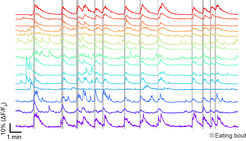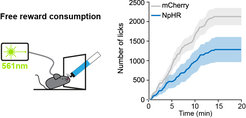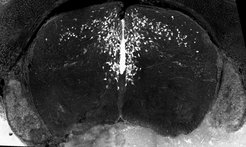Circuit dynamics and behavior
Our current focus is on the functional characterization of two microcircuits: central amygdala-mediated food consumption and spinal cord-mediated integration of motor performance and sensory processing.
Central amygdala-mediated food consumption

The amygdala has been an interest in the lab ever since we found that the EphA4 receptor promotes plasticity of neurons located in the lateral nucleus of the amygdala (Deininger et al., 2008). More recently, our interest has shifted to the central amygdala (CeA), a forebrain structure comprised of a highly interconnected network of inhibitory GABAergic neurons that consist of functionally distinct subpopulations based on expression of molecular markers.
We recently discovered that one molecularly defined CeA subpopulation positively modulates feeding (Douglass, Kucukdereli, Ponserre, et. al., 2017). Using optogenetic and pharmacogenetic tools in the mouse, we demonstrate that CeA neurons expressing the serotonin receptor Htr2a (CeAHtr2a neurons) are active during and promote food consumption. These neurons do so even in the absence of hunger, but they do not increase the motivation for food seeking. Ablation of these neurons does not affect daily food intake or body weight, suggesting that they do not play a role in long-term energy homeostasis.

Instead, we find that CeAHtr2a neuron activity is intrinsically positively reinforcing, as mice readily perform behavioral assays to self-stimulate these neurons by intracranial photostimulation. Moreover, we can change the preference of mice for a specific flavor by pairing the consumption of flavored substances with CeAHtr2a photostimulation. Silencing the activity of CeAHtr2a neurons reduces the consumption of highly appetizing liquid food, when mice are not hungry. Together these data suggest that CeAHtr2a neurons modulate food consumption by influencing the rewarding properties of food. Silencing the activity of CeAHtr2a neurons reduces food consumption as eating is no longer positively reinforced.
Spinal cord-mediated processing of sensory input and motor performance
The spinal cord contains many descending and ascending longitudinal tracts that provide motor control and perception of sensory stimuli, respectively. During our studies on spinal cord development, we had previously identified a population of spinal neurons that probably perceive tactile stimuli and send their axons into an ascending pathway towards the brain. We showed that the development of these ascending axons is controlled by ephrinB3/EphA4 forward signaling (Paixao et al., 2013).

In ongoing work, we investigate the exact function of this neuron population. Previously we showed that many of the EphA4-positive spinal neurons express the transcription factor Zic2. To gain genetic access to these neurons we generated a Zic2-Cre mouse line. Using transsynaptic viral tracing and intersectional genetics, we are currently generating an anatomical map of the microcircuit in which these neurons operate, and we are performing loss- and gain-of-function experiments to decipher their function. Our present data is consistent with the model that these neurons participate in processing somatosensory information and in controlling fine motor performance.


